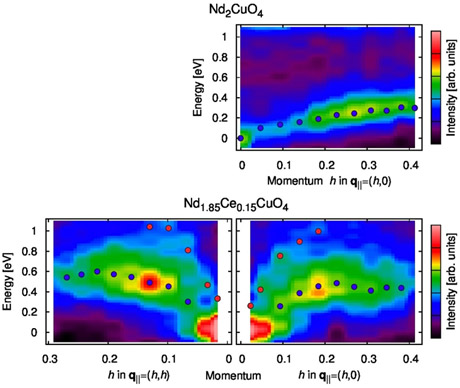- Home
- News
- Spotlight on Science
- High-Tc superconductors:...
High-Tc superconductors: key similarities and differences between electron- and hole-doped cuprates unveiled by X-rays
22-05-2014
The evolution of spin and charge excitations upon carrier doping is crucially important for understanding high-temperature superconductivity in copper oxides. High resolution resonant inelastic X-ray scattering (RIXS) measurements at the Cu L3-edge revealed that spin excitations preserve their strength in the superconducting state, both in the electron- and hole-doped superconductors, although they differ substantially in their dispersion relation.
High-Tc superconductivity in copper oxides has been a subject gaining much attention in condensed matter physics since its discovery more than 25 years ago. It occurs by doping a parent antiferromagnetic insulator with either electrons or holes. The differences or similarities between electron- and hole-doped compounds have been a central issue in the study of the copper based superconductors. Because the superconductivity in cuprates is intimately related to antiferromagnetic spin fluctuations, inelastic neutron scattering (INS) has been widely used to study the spin dynamics in the reciprocal lattice space. Very recently, high-resolution resonant inelastic X-ray scattering (RIXS) at the Cu L3-edge has become an alternative technique to measure momentum-resolved spin excitations [1,2]. RIXS can cover momentum space to large q values, where high-energy magnetic excitations are hard to measure with INS. In contrast, charge excitations, which are the counterpart of spin excitations, have been less well explored because of the limited cross section for neutron scattering; however, both spin and charge degrees of freedom should be clarified comprehensively for a definitive understanding of the electron dynamics in cuprates.
In this study, we have performed Cu L3-edge RIXS experiments of the electron-doped superconductor Nd2-xCexCuO4 at beamline ID08 using the AXES spectrometer. RIXS intensity maps as a function of momentum in the CuO2 plane (q||) and energy of the parent (x = 0) and superconducting (x = 0.15) samples are shown in Figure 1. In the parent Nd2CuO4, shape spin-wave excitations with sinusoidal dispersion dominate the RIXS spectra. When electrons are doped, as seen in the spectra of Nd1.85Ce0.15CuO4, the spectral weight clearly moves to higher energy accompanied with the broadening of the width. We also confirmed the high-energy shift of the spin excitations near the magnetic zone centre by INS. This doping evolution of the spin excitations is in distinct contrast to the hole-doped case, where the spectral distribution of the spin excitations broadens but keeps its energy position almost unchanged upon doping [3,4]. In addition to the spin excitations, we found a dispersive mode at higher energy in Nd1.85Ce0.15CuO4. Its peak positions follow the dispersion of the particle-hole charge excitations observed in the Cu K-edge RIXS spectra [5]. We therefore attribute the dispersive mode to the same origin.
From the Cu L3-edge RIXS, complemented by INS and Cu K-edge RIXS, we have clarified the doping evolution of the spin and charge excitations in the electron-doped cuprate superconductors. In Figure 2, we summarise schematically the spin and charge excitations in the parent antiferromagnetic insulator and the electron-doped superconductor. High-energy shift of the spin excitations and their mixture with the charge excitations indicate that the electron dynamics of the electron-doped cuprates has highly itinerant character in the sub-eV energy scale. In contrast, dispersion of the spin excitation in the hole-doped cuprates follows the spin-wave excitations of the parent antiferromagnetic insulator, which means that a more localised picture is suitable. Our findings impose constraints on theoretical models and a comprehensive description of the electronic excitations in the electron- and hole-doped cuprates is a prerequisite for complete understanding of the superconductivity. Finally, this type of experiment will soon become even more enlightening thanks to the ERIXS spectrometer installed at the new ID32 beamline, where a simultaneous increase of energy resolution (x5) and intensity (x3) is expected with respect to the experimental conditions of this work.
Principal publication and authors
High-energy spin and charge excitations in electron-doped copper oxide superconductors, K. Ishii (a), M. Fujita (b), T. Sasaki (b), M. Minola (c), G. Dellea (c), C. Mazzoli (c), K. Kummer (d), G. Ghiringhelli (c), L. Braicovich (c), T. Tohyama (e), K. Tsutsumi (b), K. Sato (b), R. Kajimoto (f), K. Ikeuchi (g), K. Yamada (h), M. Yoshida(a,i), M. Kurooka (i), J. Mizuki (a,i), Nature Communications 5, 3714 (2014).
(a) Japan Atomic Energy Agency, Sayo (Japan)
(b) Tohoku University, Sendai (Japan)
(c) Politecnico di Milano, Milano (Italy)
(d) ESRF
(e) Kyoto University, Kyoto (Japan)
(f) J-PARC Center, Tokai (Japan)
(g) Comprehensive Research Organization for Science and Society, Tokai (Japan)
(h) High Energy Accelerator Research Organization, Tsukuba (Japan)
(i) Kwansei Gakuin University, Sanda (Japan)
References
[1] L.J.P. Ament et al., Phys. Rev. Lett. 103, 117003 (2009).
[2] L. Braicovich et al., Phys. Rev. Lett. 104, 077002 (2010).
[3] M. Le Tacon et al., Nature Phys. 7, 725-730 (2011).
[4] M.P.M. Dean et al., Nature Mater. 12, 1019 (2013).
[5] K. Ishii et al., Phys. Rev. Lett. 94, 207003 (2005).
[6] S. Wakimoto et al., Phys. Rev. B 87, 104511 (2013).
Top image: The new ID32 beamline is currently under construction. Pictured here is the RIXS end station's spectrometer support which glides along a 25 metre path around the sample.





